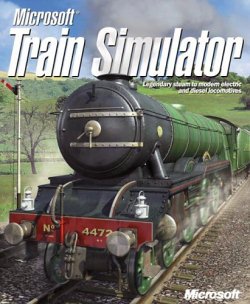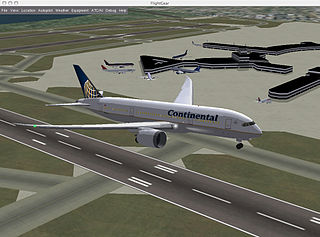2007–2009: Second attempt
| Microsoft Train Simulator 2 | |
|---|---|
 | |
| Developer(s) | Aces Game Studio |
| Publisher(s) | Microsoft Game Studios |
| Designer(s) | Rick Selby |
| Series | Microsoft Train Simulator |
| Platform(s) | PC – Windows XP, Windows Vista, Windows Server 2008 Windows 7 |
| Release | Cancelled |
| Genre(s) | Vehicle simulation |
| Mode(s) | Single Player |
The re-launch attempt at Microsoft's second version of the "Train Simulator" project was officially announced on January 19, 2007. This time around the simulation was instead being made in-house by Microsoft's Aces Game Studio, which was most known for its successful Microsoft Flight Simulator series line, as a part of the "Games for Windows" initiative.
Development
The simulation leveraged most of the existing core components of Microsoft Flight Simulator X's platform, thus providing an entire earth model in which to play from, and was planned to be compatible with both Windows Vista and Windows XP. A post on 'The Little Wheel Goes in Back' blog, written by one of the developers, confirmed the working title was 'Train Simulator 2'. [7]
Microsoft's first demonstration of Train Simulator 2 occurred on August 25, 2007 at the Games Convention in Leipzig, Germany and released an official press kit which included several in-game visual prototype images, asset renders, and two videos. One of these videos presents a brief demonstration of the simulation's ability to model the entire planet's track corridors, reproducing a similar concept in Microsoft's Flight Simulator series, with global rail network data for anyone to operate their trains around freely without limits. [8] The data would have also been available to route builders for modification of any kind to suit their modeling needs anywhere in the world. As opposed to starting an entire route from scratch, this would require more or less simple cosmetic details and object placement.
Despite having the name in common with its predecessor, backwards compatibility with the first version of Train Simulator would not have been possible due to the completely different base platform used for development and programming designs between the two versions. The original Microsoft Train Simulator uses routes based on individual levels which are loaded separately within the application, whereas this version would have introduced the entire world as a single game playing area where railroad corridors would have been based on their actual real-world locations just as in Flight Simulator.
Routes
In addition to the entire global earth model from which Flight Simulator X was based, Train Simulator 2 was also going to feature four high-detail routes, including the following lines, along with their respective railroad carriers:
| Route name | Featured trains | Rolling stock | Terminal stations | km | miles | Set in | Country | Notes |
|---|---|---|---|---|---|---|---|---|
| Horseshoe Curve | Norfolk Southern | Dash 9-40CW SD40-2 High Nose | Norfolk Southern's "Pittsburgh Line" from Altoona to Johnstown, Pennsylvania. [9] | — | — | 2000s | | — |
| Stevens Pass | BNSF | Dash 9-44CW GP38-2 SD40-2 | BNSF Railway's "Scenic Subdivision" from Everett to Wenatchee, Washington. [10] | — | — | 2000s | | — |
| BLS Lötschbergbahn | SBB | Re460 | BLS's "Lötschberg Line" from Thun to Interlaken and Brig, Switzerland. [11] | — | — | 2000s | | — |
| Cologne–Düsseldorf | DB | ICE 3 | Deutsche Bahn's "ICE" route from Cologne to Duisburg, Germany. [12] | — | — | 2000s | | — |
Locomotives
The second attempt contained unknown drivable locomotives and multiple units; unknown if MSTS 2 would have featured AI-only trains, or a static in-game number.
| Locomotive | Image | Ingame number | Type | mph | km/h | Built | Country | Route | Livery(s) | Notes |
|---|---|---|---|---|---|---|---|---|---|---|
| Dash 9-40CW |  | 9039 9713 | Diesel | 70 | 112 | 1993 | | Horseshoe Curve | Norfolk Southern | — |
| Dash 9-44CW |  | 4897 | Diesel | 70 | 112 | 1993 | | Stevens Pass | BNSF | — |
| GP38-2 |  | 2264 | Diesel | 70 | 112 | 1972 | | Stevens Pass | BNSF | — |
| SD40-2 |  | 7184 | Diesel | 70 | 112 | 1972 | | Stevens Pass | BNSF | — |
| SD40-2 High Nose |  | 5095 | Diesel | 70 | 112 | 1972 | | Horseshoe Curve | Norfolk Southern | — |
| Re 460 |  | 014 | Electric | 120 | 200 | 1991 | | BLS Lötschbergbahn | SBB Dark Blue | — |
| ICE 3 |  | — | Electric | 200 | 320 | 2000 | | Cologne–Duisburg | DB | — |
Closure of the Aces Game Studio
On January 23, 2009, Microsoft announced that it was permanently closing its Aces Game Studio, the internal development studio responsible for the Microsoft Flight Simulator series and the development of Microsoft Train Simulator 2. As a result, all future development on Train Simulator 2 (which was just entering the final stages of development at the time of closure) was immediately halted, marking the second time that this project was terminated. [2] [3] A week later, Microsoft issued the following official announcement from Train Simulator Insider.
January 30, 2009 – By now, many of you have heard that Microsoft has closed Aces Studio, the publisher of Microsoft Flight Simulator and Microsoft Train Simulator. This was not a reflection of the quality of the products Aces has developed, the sales performance of the games, or the quality of the team at Aces. This difficult decision was made to align Microsoft’s resources with our strategic priorities. As a result of this difficult decision, development of the next version of Train Simulator is being postponed for an indefinite period.
Microsoft Game Studios is investing significant resources in many exciting and new areas of gaming and entertainment, including Windows games. We believe these future investments will push innovation, community, and collaboration to unprecedented levels and will provide more synergy with our ongoing investments in Games for Windows - LIVE as well as other Windows entertainment technologies.
We are humbled and proud of the passion and support that the Train Simulator franchise has developed. This includes you, the large community of railroading simmers, as well as the vibrant third-party ecosystem that has developed around the game. Thank you for your understanding of our decision and for your continued support. [13]
Information regarding the product can be found on Microsoft's official Train Simulator website, through the Internet Archive's Wayback Machine. [14]
On October 12, 2009, former Aces Game Studio directors, Rick Selby and Kathie Flood, announced the launch of a new simulations-based development studio named Cascade Game Foundry. [15] Their first independent release was a scuba diving simulation game titled Infinite Scuba, released in 2013. [16]











